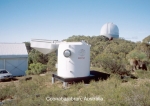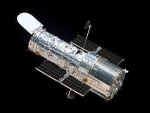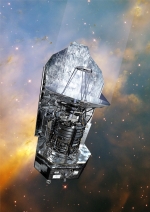Displaying items by tag: telescope
SOFIA observatory
The Stratospheric Observatory for Infrared Astronomy (SOFIA) is a joint project of NASA and the German Aerospace Center ( DLR) to construct and maintain an airborne observatory. NASA awarded the contract for the development of the aircraft, operation of the observatory and management of the American part of the project to the Universities Space Research Association (USRA) in 1996.
The DSI (Deutsches SOFIA Institut) manages the German parts of the project which are primarily science and telescope related. SOFIA's telescope saw first light on May 26, 2010. SOFIA is the successor to the Kuiper Airborne Observatory.
High Energy Stereoscopic System (HESS)
The High Energy Stereoscopic System (H.E.S.S.) is a next-generation system of Imaging Atmospheric Cherenkov Telescopes (IACT) for the investigation of cosmic gamma rays in the 100 GeV and TeV energy range. The acronym was chosen in honour of Victor Hess, who was the first to observe cosmic rays.
The name also emphasizes two main features of the currently-operating installation, namely the simultaneous observation of air showers with several telescopes, under different viewing angles, and the combination of telescopes to a large system to increase the effective detection area for gamma rays.
H.E.S.S. permits the exploration of gamma-ray sources with intensities at a level of a few thousandth parts of the flux of the Crab Nebula. H.E.S.S. has four telescopes, each with a mirror just under 12m in diameter, arranged 120m apart from each other in a square. A larger telescope with a 30m mirror called H.E.S.S. Phase 2, constructed in the centre of the array, saw its first light at 0:43 a.m. on 26 July 2012.
As with other gamma-ray telescopes, H.E.S.S. observes high energy processes in the universe. Gamma-ray producing sources include supernova remnants, active galactic nucleii and pulsar wind nebulae. It also actively tests unproven theories in physics such as looking for the predicted gamma-ray annihilation signal from WIMP dark matter particles and testing lorentz invariance predictions of loop quantum gravity.
The H.E.S.S. observatory is operated by the collaboration of more than 170 scientists, from 32 scientific institutions and 12 different countries: Namibia and South Africa, Germany, France, the UK, Ireland, Austria, Poland, the Czech Republic, Sweden, Armenia, and Australia. To date (Aug. 2012), the H.E.S.S. Collaboration has published over 100 articles in high-impact scientific journals, including the top-ranked ‘Nature’ and ‘Science’ journals.
Space Telescope Science Institute
The Space Telescope Science Institute (STScI) is the science operations center for the Hubble Space Telescope (HST; in orbit since 1990) and for the James Webb Space Telescope (JWST; scheduled to be launched in 2018).
STScI is located on the Johns Hopkins University Homewood campus in Baltimore, Maryland and was established in 1981 as a community-based science center that is operated for NASA by the Association of Universities for Research in Astronomy (AURA). In addition to performing continuing science operations of HST and preparing for scientific exploration with JWST, STScI manages and operates the Multi-mission Archive at Space Telescope (MAST), the Data Management Center for the Kepler mission and a number of other activities benefiting from its expertise in and infrastructure for supporting the operations of space-based astronomical observatories. Most of the funding for STScI activities comes from contracts with NASA's Goddard Space Flight Center but there are smaller activities funded by NASA's Ames Research Center, NASA’s Jet Propulsion Laboratory, and the European Space Agency (ESA).
The staff at STScI consists of scientists (mostly astronomers and astrophysicists), software engineers, data management and telescope operations personnel, education and public outreach experts, and administrative and business support personnel.
James Webb Space Telescope (JWST)
The James Webb Space Telescope (JWST), previously known as Next Generation Space Telescope (NGST), is a planned space telescope optimized for observations in the infrared, and a scientific successor to the Hubble Space Telescope and the Spitzer Space Telescope. The main technical features are a large and very cold 6.5 meter diameter mirror, an observing position far from Earth, orbiting the Earth–Sun L2 point, and four specialized instruments. The combination of these features will give JWST unprecedented resolution and sensitivity from long-wavelength visible to the mid-infrared, enabling its two main scientific goals — studying the birth and evolution of galaxies, and the formation of stars and planets.
Organization: NASA, with significant contributions from ESA and CSA.
Advanced Technology Solar Telescope (ATST)
The Advanced Technology Solar Telescope (ATST) is a large domed solar telescope facility that is planned to be built by the National Solar Observatory atop the Haleakala volcano on the Pacific island of Maui, Hawaii, USA. The site was selected for its clear daytime atmospheric seeing conditions, which will enable study of the solar corona. The ATST enclosure will house a 4-meter diameter solar telescope capable of observing objects on the Sun that are 30 km across.
The ATST aims to resolve the fundamental interactions between solar magnetic fields and the dynamic atmospheric plasma on scales below 0.1 arcsec over entire active regions.
The ATST is a collaboration of 22 institutions, reflecting a broad segment of the solar physics community.
ROTSE
The Robotic Optical Transient Search Experiment (ROTSE) is an multi-telescope experiment designed to observe the optical afterglow of gamma-ray bursts. The experiment currently consists of four telescopes located in Australia, Namibia, Turkey, and at the McDonald Observatory near Fort Davis, Texas.
The ROTSE project is a collaboration of astrophysicists from the University of Michigan, Los Alamos National Laboratory, Lawrence Livermore National Laboratory, the University of New South Wales (Australia) and the Max Planck Institute for Nuclear Physics (Germany).
The original ROTSE-I had 4 telephoto lenses of 11 cm aperture, covering a 16x16 degree field of view. This detected the first afterglow of a GRB while the burst was still ongoing, but this was the only burst detected by ROTSE or the very similar Livermore Optical Transient Imaging System. Therefore ROTSE-II was designed, also featuring a large field of view, but it was never built, since new satellites such as HETE-2 and SWIFT could provide smaller error boxes, making a huge field of view unnecessary. This led to the design of ROTSE-III, a more or less conventional telescope designed for fast slewing and operation at multiple locations around the world.
Hubble Space Telescope
The Hubble Space Telescope (HST) is a space telescope that was carried into orbit by a Space Shuttle in 1990 and remains in operation. A 2.4 meter (7.9 ft) aperture telescope in low Earth orbit, Hubble's four main instruments observe in the near ultraviolet, visible, and near infrared. The telescope is named after the astronomer Edwin Hubble.
Hubble's orbit outside the distortion of Earth's atmosphere allows it to take extremely sharp images with almost no background light. Hubble's Ultra-Deep Field image, for instance, is the most detailed visible-light image ever made of the universe's most distant objects. Many Hubble observations have led to breakthroughs in astrophysics, such as accurately determining the rate of expansion of the universe.
Although not the first space telescope, Hubble is one of the largest and most versatile, and is well known as both a vital research tool and a public relations boon for astronomy. The HST was built by the United States space agency NASA, with contributions from the European Space Agency, and is operated by the Space Telescope Science Institute. The HST is one of NASA's Great Observatories, along with the Compton Gamma Ray Observatory, the Chandra X-ray Observatory, and the Spitzer Space Telescope.
Space telescopes were proposed as early as 1923. Hubble was funded in the 1970s, with a proposed launch in 1983, but the project was beset by technical delays, budget problems, and the Challenger disaster. When finally launched in 1990, scientists found that the main mirror had been ground incorrectly, significantly compromising the telescope's capabilities. However, after a servicing mission in 1993, the telescope was restored to its intended quality.
Hubble is the only telescope designed to be serviced in space by astronauts. Between 1993 and 2002, four missions repaired, upgraded, and replaced systems on the telescope, but a fifth mission was canceled on safety grounds following the Columbia disaster. However, after spirited public discussion, NASA administrator Mike Griffin approved one final servicing mission, completed in 2009. The telescope is now expected to function until at least 2014. Its scientific successor, the James Webb Space Telescope (JWST), is to be launched in 2018 or possibly later.
Herschel Space Observatory
A space telescope observing in the far-infrared.
The Herschel Space Observatory is a European Space Agency space observatory sensitive to the far infrared and submillimetre wavebands. It is the largest infrared space telescope ever launched, carrying a single mirror of 3.5 metres (11.5 ft) in diameter.
The observatory was carried into orbit in May 2009, reaching the second Lagrangian point (L2) of the Earth-Sun system, 1,500,000 kilometres (930,000 mi) from the Earth, about two months later. Herschel is named after Sir William Herschel, the discoverer of the infrared spectrum and planet Uranus.
The Herschel Observatory is capable of seeing the coldest and dustiest objects in space; for example, cool cocoons where stars form and dusty galaxies just starting to bulk up with new stars. The observatory will sift through star-forming clouds—the "slow cookers" of star ingredients—to trace the path by which potentially life-forming molecules, such as water, form. The United States through NASA is participating in the ESA-built and -operated observatory. It is the fourth 'cornerstone' mission in the ESA science program, along with Rosetta, Planck, and the Gaia mission.
COROT
COROT (French: COnvection ROtation et Transits planétaires; English: COnvection ROtation and planetary Transits) is a space mission led by the French Space Agency (CNES) in conjunction with the European Space Agency (ESA) and other international partners.
The mission's two objectives are to search for extrasolar planets with short orbital periods, particularly those of large terrestrial size, and to perform asteroseismology by measuringsolar-like oscillations in stars. It was launched at 14:28:00 UTC on 27 December 2006, atop a Soyuz 2.1b carrier rocket, reporting first light on 18 January 2007. Subsequently, the probe started to collect science data on 2 February 2007. COROT is the first spacecraft dedicated to the detection of transiting extrasolar planets, opening the way for more advanced probes such as Kepler and possibly TESS and PLATO. It detected its first extrasolar planet, COROT-1b, in May 2007, just 3 months after the start of the observations. Mission flight operations were originally scheduled to end 2.5 years from launch but operations were extended to 2013.
NuSTAR Telescope
Nuclear Spectroscopic Telescope Array (NuSTAR) is a planned space-based X-ray telescope that will use a Wolter telescope to focus high energy X-rays at 5 to 80 keV from astrophysical sources, especially for nuclear spectroscopy. It is the eleventh mission of the NASA Small Explorer satellite program (SMEX-11) and the first space-based direct-imaging X-ray telescope at energies beyond those of the Chandra X-ray Observatory and XMM-Newton.
Mission launch is scheduled for 21 March 2012.
Its primary scientific goals are to conduct a deep survey for black holes a billion times more massive than our sun, understand how particles are accelerated to within a fraction of a percent of the speed of light in active galaxies, and understand how the elements are created in the explosions of massive stars by imaging the remains, which are called supernova remnants.
NuSTAR employs two grazing incidence focusing optics each of which consists of 133 concentric shells. The optics used were coated by DTU Space in Copenhagen and assembled at the Nevis Laboratories of Columbia University.
Partners:
The principal investigator is the California Institute of Technology (Caltech). Other major partners include the Jet Propulsion Laboratory (JPL), University of California at Berkeley, Danish Technical University (DTU),Columbia University, Goddard Space Flight Center, Stanford University, University of California, Santa Cruz,Sonoma State University, Lawrence Livermore National Laboratory, and the Italian Space Agency (ASI). NuSTAR's major industrial partners include Orbital Sciences Corporation and ATK Space Systems-Goleta.










